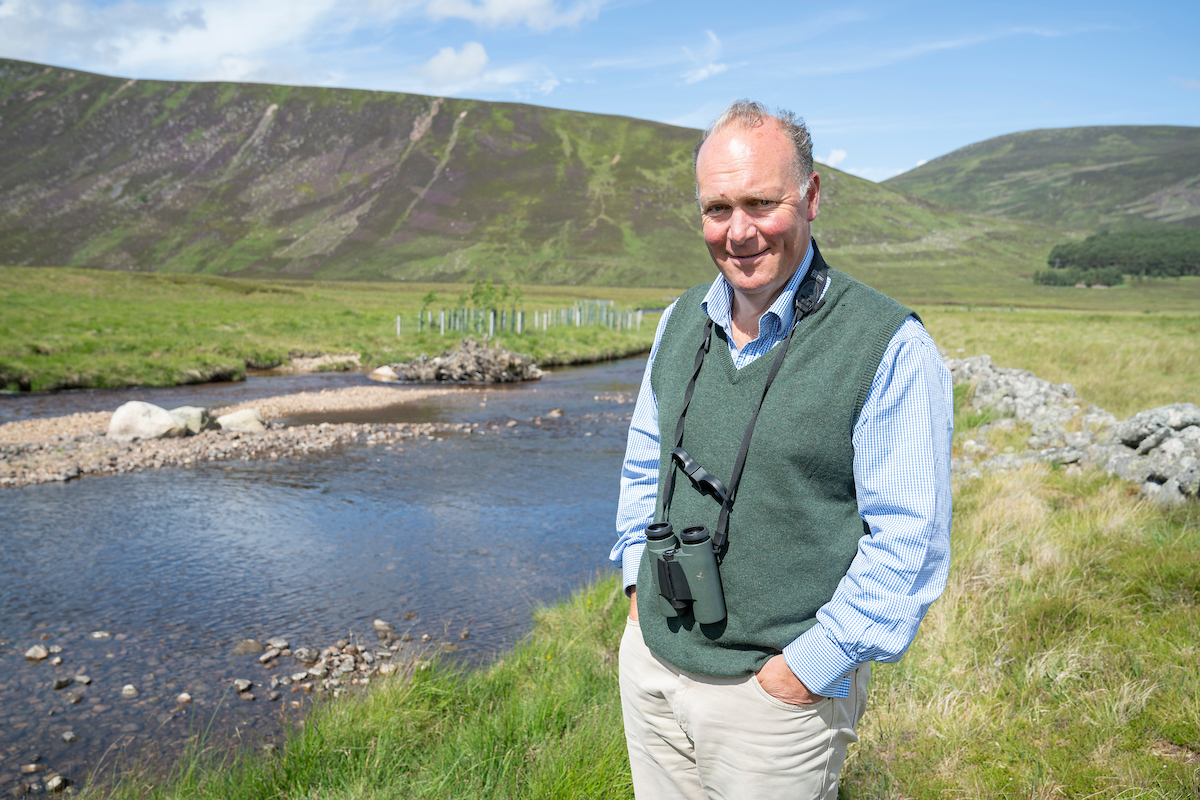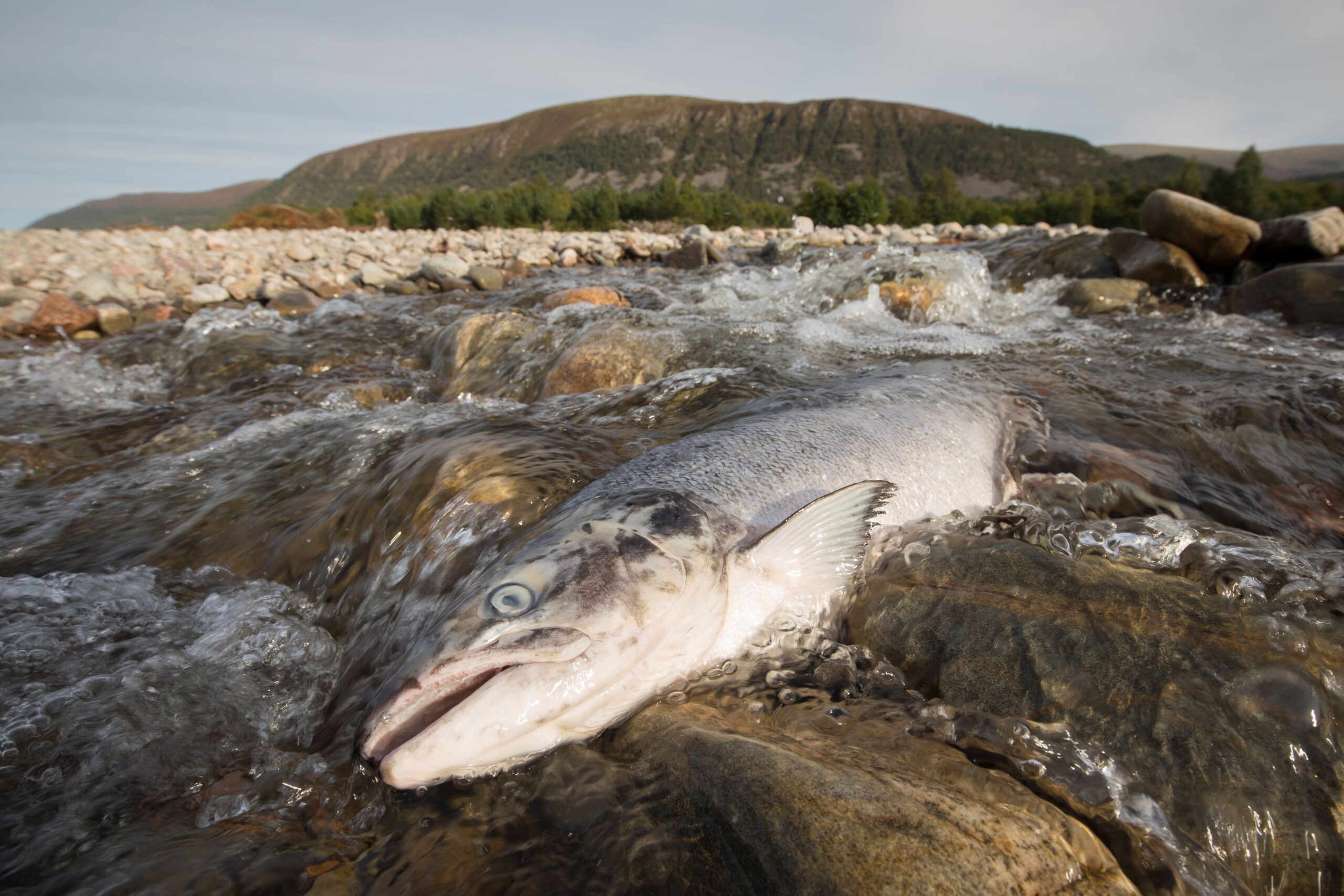Royal Riverwoods
Words by Hugh Webster
Images by Mark Hamblin, Tierney Lloyd, Susan Cooksley, James Shooter & Peter Cairns
Words by Hugh Webster
Images by Mark Hamblin, Tierney Lloyd, Susan Cooksley, James Shooter & Peter Cairns
‘I’m an inveterate Wombler,’ says Richard Gledson, plucking a plastic packet out of the river. Richard is the factor for the Balmoral Estate on Deeside, and has invited us here to see the work his team have been doing to restore natural processes on the River Muick, an upland tributary of the mighty Dee. The Dee catchment is designated as a Special Area of Conservation for its importance to Atlantic salmon, freshwater pearl mussels and otters. However, like rivers across Scotland, there’s trouble beneath the surface.

‘In 2012, more than ten thousand salmon were caught on the Dee,’ Richard recalls. ‘Last year, that number was down to a little over two thousand.’
The once unimaginable possibility that salmon might one day disappear from this river, is beginning to hit home.
Still, Richard believes there are things that can be done to avoid this doomsday scenario. The royal estate is already engaged in tree-planting efforts and peatland restoration, but many of the benefits this work promises to yield – like increased shade and cleaner water – will only manifest in the longer term. Working with the River Dee Trust, the Balmoral Estate team sought an intervention with immediate impact. Looking to North America, they noted the role of trees that had fallen into rivers in helping to create habitats and diversify flows. This inspired a plan to insert dead trees into the River Muick, an idea that would have once seemed absurd.
‘Historically, we were so tidy minded,’ recalls Richard with a rueful smile. ‘If a tree fell into the river, you’d be told to take it out!’ But times have changed, and King Charles was quickly convinced of the plan’s potential benefits. ‘His Majesty is keen for us to do as much as we can to improve the environment,’ says Richard, ‘and if that encourages others to follow our example, then we’d be delighted.’
The wider aim is to restore natural river processes. Trees once lined Scotland’s upland rivers until centuries of logging, burning and grazing left the riverbanks denuded and exposed. Now, with the natural supply of treefalls interrupted, engineers have calculated where to site deadwood in the river to replicate natural processes. ‘In a hundred years, with all the trees that we’re planting, some of them will fall into the river naturally,’ says Richard. ‘In the meantime, we’re giving nature a helping hand.’
‘His Majesty is keen for us to do as much as we can to improve the environment.’
Without trees to divert its flow, the headwaters of the River Muick had become broad and shallow, making the river quick to warm in the sun. Marine Scotland Science has had temperature monitors throughout the catchment for years, recording the increases. In recent years, the Dee’s tributaries have reached a water temperature of 27.5°C, close to the lethal level for juvenile salmon. ‘Warmer water holds less dissolved oxygen,’ explains Richard, ‘and, at the temperatures we are beginning to see, it becomes impossible for fish to survive. So, that’s why we started looking at how we could use natural processes to reverse human impact.’
Eventually, the hope is that trees will shade the riverbanks, cooling the water and thus boosting oxygen levels, but in the meantime, the woody structures that Richard’s team has placed into the river are helping in other ways. By diverting the flow around their sunken root plates, the trees create scours of deeper, cooler water, offering a vital retreat for overheating fish. And, having divided the main flow, the water is then accelerated over shallow gravel beds, perfect for spawning fish.
‘We have seen mature salmon sheltering in these pools.’
The tree roots also offer hiding places for young fish that were previously vulnerable to predators, while swirling eddies form behind every obstacle, creating welcome shelter from the fierce floodwaters that periodically rise here in sudden spates. ‘We have seen mature salmon sheltering in these pools,’ says Richard, ‘and the fry and parr take advantage of them too.’
The flow of the increasingly wooded River Feshie catchment to the west of Balmoral, is being shaped by fallen trees and accumulating deadwood in the river channel.
There was some concern that the enormous chunks of ice that calve off from Loch Muick in the spring might dislodge the sunken trees, but in the three years they have been in place, just one structure has moved, and only by a few metres. The trunks are secured under heavy boulders, buttressing their root plates against the press of water, and so the trees have stayed put, settling into the river beneath growing skirts of flood-borne stones. ‘It’s been an easy sell in the end,’ reflects Richard. ‘I don’t think anyone can object. Creating this complexity from a previously simplified river just makes sense.’
The success of the project has fostered an appetite to embrace other natural processes. There is more riparian planting planned, together with the addition of more woody structures into other tributaries. Side channels of the River Muick have been reconnected with the main stem, refreshing the vital supply of gravel sediments into the river, replenishing the shallow spawning beds that were becoming scraped clean of their smaller stones by repeated floods.
There is even an innovative nutrient enhancement project underway, exploring the use of deer bones to boost nutrient availability in these upland water courses. ‘Historically, these rivers hosted huge numbers of salmon, bringing vast amounts of nutrients up into the headwaters all the way from the sea,’ says Richard. ‘We don’t have anything like those numbers of salmon now, nor do we yet have much nutrient input from the new woodlands, so we’re trying something else.’

The flow of the increasingly wooded River Feshie catchment to the west of Balmoral, is being shaped by fallen trees and accumulating deadwood in the river channel.
After 2023’s dry spring, the river is still shallow enough to wade across in places, but there are fast-flowing riffles and dark pools either side of where Richard stands mid-stream – vital river features that only exist thanks to the woody structures. These dead trees create islands of life, colonised by ragwort, foxgloves, ferns and rushes, but it’s below the surface that they’re having the greatest effects.
Scotland’s salmon face many threats. Climate change is causing more extreme droughts and more intense floods, warming our rivers and driving a dangerous drop in oxygen levels. ‘In order to get these systems back running properly, we need to ensure we have as many healthy wild smolts going out to sea as we can,’ says Richard, gazing at the water flowing around him in growing loops and swirls. ‘Getting more trees in our rivers is one way we can help achieve that.’